Day 7: Orbetello
It is a beautiful morning....the sun is shining as we drive to Pitigliano. The scenery in the area is very distinctive....the town seems to grow right out of the tufa substructure.
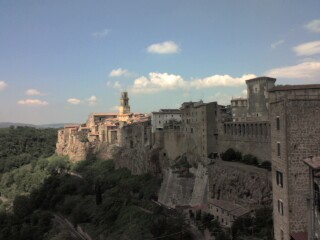

There are lots of Etruscan places around here...tombs are scattered through the countryside.
Pitigliano is also known as "La Piccola Gerusalemme (Little Jerusalem)" because it had a significant Jewish population (up to 20% at one time) from the 16th century until the early 20th century. There are no Jews left in Pitigliano--the last remant left during and after World War II--but the town has kept its Jewish heritage alive. The synagogue was restored in 1995 and since our previous visit in 1998, the Jewish ghetto sites have been reorganized into a cohesive unit--the synagogue, a small museum of the Jewish religion (mostly aimed at non-Jewish visitors), the matzoh bakery, the wine cellar, the mikvah and a small library.
The synagogue is very attractive but is rarely used anymore.....sometimes weddings or bar mitzvahs are held there but it is mostly open as a tourist attraction.
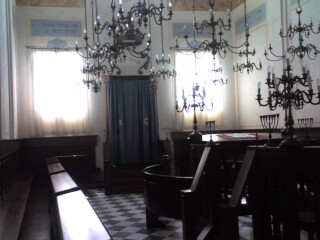


The women's gallery is upstairs behind a carved screen and the view down into the sanctuary is obscured.

The mikvah (ritual bath), the tannery and the wine cellar are in caves carved out of the tufa rock
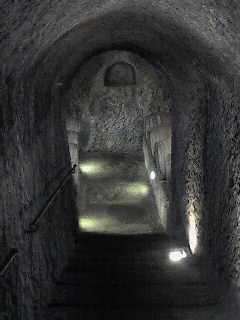
and the bakery still has the oven for making matzah
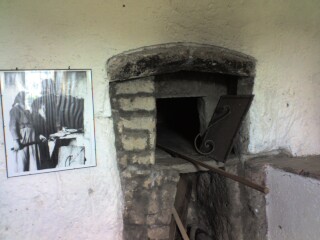
and a window grating with a design in the form of a menorah.
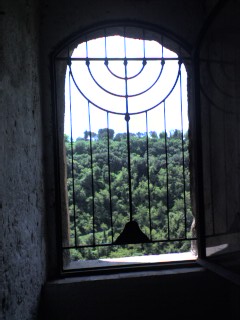
It is quite an impressive restoration, especially given the fact that there are no Jews in Pitigliano but the project has received a lot of interest in Jewish communities elsewhere and has quite a following internationally.
Walking around Pitigliano today, it is another attractive Italian hill town...the same narrow streets, houses with flowers in window boxes, inviting shops, an acqueduct built into the town walls, a dominating castle of the Orsini family which now houses a museum and wonderful views over the countryside from all parts of the town.
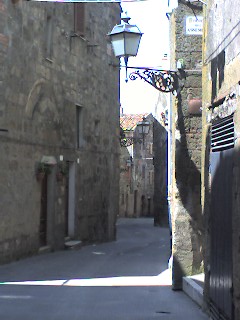


Since it is lunch time, we stop at an "alimentari" to have some sandwiches made and move on to the next "citta di tufa"--Sorano. Sorano is a bit more difficult to get a hold of...it is built into the side of the hill and it isn't apparent to us on our first run through town where to stop. And once we get through town, we have to drive about three kilometers on a steep, narrow, winding road before we find a place to turn around. We are rewarded on our return drive with spectacular views of the town clinging to the side of the cliff, with a big fortress overhanging it all.

We do find the center, park and find a bench in the middle of town where we eat our sandwich. But after a brief walk through the old section (which is picturesque but definitely crumbling), we leave and drive to Sovana, the last of this trio of towns in the area.
We had read that Sovana was very small (only one street) and one guidebook says it only has 23 residents. (We later learn that there are now 116 residents in Sovana.) The sign at the entrance to town advertises it (in Italian) as one of the most beautiful villages in Italy which naturally leads to some skepticism. The streets in town are paved with bricks in a very careful herringbone pattern and as we enter into the main piazza, we are greeted by a lovely small church, a minature town hall, a few attractive restaurants, bars and churches and a hotel built into the old stables.
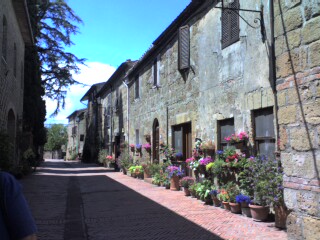
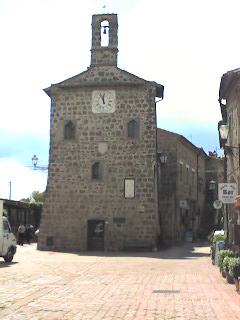
It turns out that the town is in fact extremely pleasing and harmonious. It is bigger than we imagined with a couple more hotels, a large and very impressive duomo at one end of town with intricate carvings on the doorway and on the interior columns
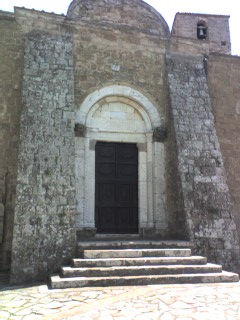

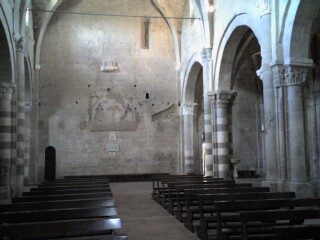
In addition, the bookshop connected to the duomo has an impressive collection...including some in English and a charming salesperson who helps us find D.H. Lawrence's "Etruscan Days" and a well organized book that includes descriptions and pictures of most of the Etruscan sites we have visited. And before we leave town, Diana buys a pocketbook at the very stylish leather store in town (which is even open in the early afternoon) and we get a gelato and a freshly squeezed orange juice at a gelateria at the edge of the parking lot.
To cap it all off, there is a ruined castle at the other end of town with picnic tables where we can eat on our next visit to Sovana.
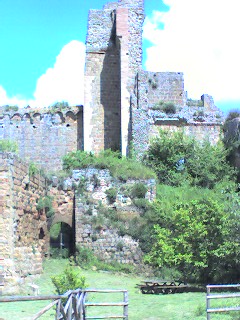
Sovana, while small, seems to have it all.....and we will be happy to return in the future.
Back in Orbetello, we sit by the water and watch the sun set over the lagoon

and have our farewell dinner at a pleasant little trattoria in the center of town, Il Nocchino. Diana has a pretty good (but very rich) risotto followed by a steak. I have a delicious "saute" of excellent mussels and a superior "fritto misto". We drink a very pleasant Bianco di Pitigiano that gets finished very easily.
Tomorrow we are off to Lerici.


There are lots of Etruscan places around here...tombs are scattered through the countryside.
Pitigliano is also known as "La Piccola Gerusalemme (Little Jerusalem)" because it had a significant Jewish population (up to 20% at one time) from the 16th century until the early 20th century. There are no Jews left in Pitigliano--the last remant left during and after World War II--but the town has kept its Jewish heritage alive. The synagogue was restored in 1995 and since our previous visit in 1998, the Jewish ghetto sites have been reorganized into a cohesive unit--the synagogue, a small museum of the Jewish religion (mostly aimed at non-Jewish visitors), the matzoh bakery, the wine cellar, the mikvah and a small library.
The synagogue is very attractive but is rarely used anymore.....sometimes weddings or bar mitzvahs are held there but it is mostly open as a tourist attraction.



The women's gallery is upstairs behind a carved screen and the view down into the sanctuary is obscured.

The mikvah (ritual bath), the tannery and the wine cellar are in caves carved out of the tufa rock

and the bakery still has the oven for making matzah

and a window grating with a design in the form of a menorah.

It is quite an impressive restoration, especially given the fact that there are no Jews in Pitigliano but the project has received a lot of interest in Jewish communities elsewhere and has quite a following internationally.
Walking around Pitigliano today, it is another attractive Italian hill town...the same narrow streets, houses with flowers in window boxes, inviting shops, an acqueduct built into the town walls, a dominating castle of the Orsini family which now houses a museum and wonderful views over the countryside from all parts of the town.



Since it is lunch time, we stop at an "alimentari" to have some sandwiches made and move on to the next "citta di tufa"--Sorano. Sorano is a bit more difficult to get a hold of...it is built into the side of the hill and it isn't apparent to us on our first run through town where to stop. And once we get through town, we have to drive about three kilometers on a steep, narrow, winding road before we find a place to turn around. We are rewarded on our return drive with spectacular views of the town clinging to the side of the cliff, with a big fortress overhanging it all.

We do find the center, park and find a bench in the middle of town where we eat our sandwich. But after a brief walk through the old section (which is picturesque but definitely crumbling), we leave and drive to Sovana, the last of this trio of towns in the area.
We had read that Sovana was very small (only one street) and one guidebook says it only has 23 residents. (We later learn that there are now 116 residents in Sovana.) The sign at the entrance to town advertises it (in Italian) as one of the most beautiful villages in Italy which naturally leads to some skepticism. The streets in town are paved with bricks in a very careful herringbone pattern and as we enter into the main piazza, we are greeted by a lovely small church, a minature town hall, a few attractive restaurants, bars and churches and a hotel built into the old stables.


It turns out that the town is in fact extremely pleasing and harmonious. It is bigger than we imagined with a couple more hotels, a large and very impressive duomo at one end of town with intricate carvings on the doorway and on the interior columns



In addition, the bookshop connected to the duomo has an impressive collection...including some in English and a charming salesperson who helps us find D.H. Lawrence's "Etruscan Days" and a well organized book that includes descriptions and pictures of most of the Etruscan sites we have visited. And before we leave town, Diana buys a pocketbook at the very stylish leather store in town (which is even open in the early afternoon) and we get a gelato and a freshly squeezed orange juice at a gelateria at the edge of the parking lot.
To cap it all off, there is a ruined castle at the other end of town with picnic tables where we can eat on our next visit to Sovana.

Sovana, while small, seems to have it all.....and we will be happy to return in the future.
Back in Orbetello, we sit by the water and watch the sun set over the lagoon

and have our farewell dinner at a pleasant little trattoria in the center of town, Il Nocchino. Diana has a pretty good (but very rich) risotto followed by a steak. I have a delicious "saute" of excellent mussels and a superior "fritto misto". We drink a very pleasant Bianco di Pitigiano that gets finished very easily.
Tomorrow we are off to Lerici.
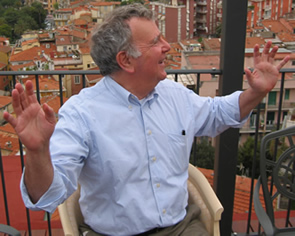

0 Comments:
Post a Comment
<< Home